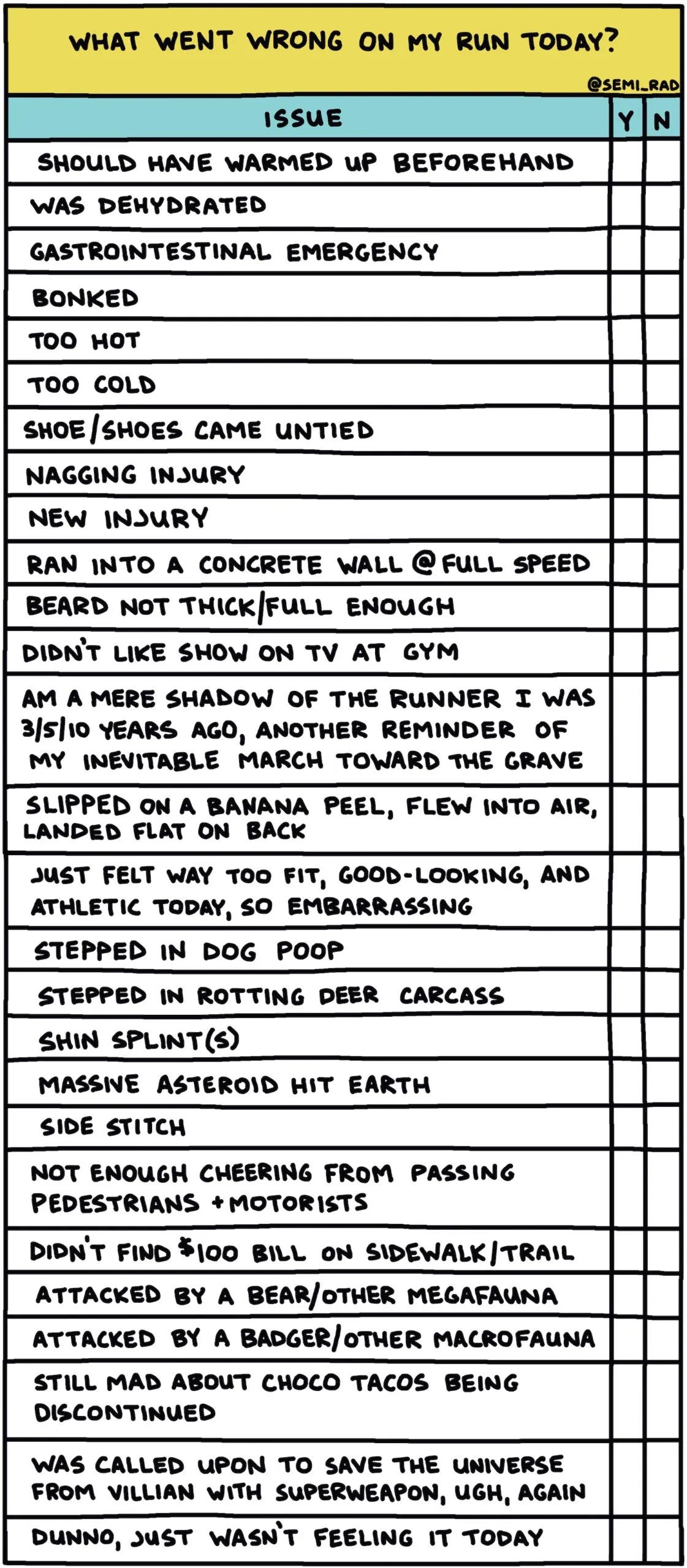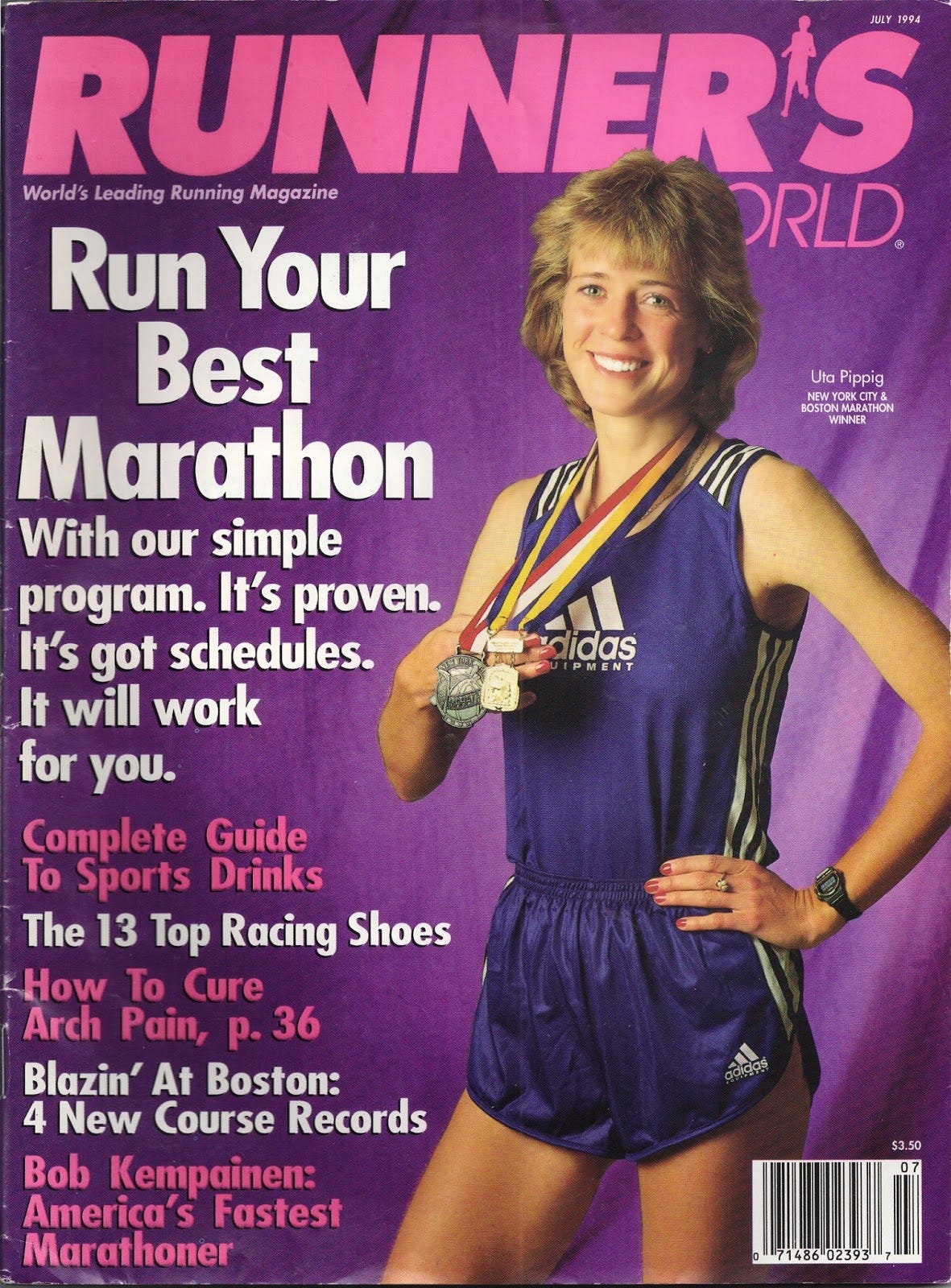Welcome to another hump-day edition. Thanks to the feedback on my last wimpy-winter post, I felt emboldened to sign up for a three-day women’s alpine ski camp at month’s end. Maybe there’s still hope for me to become a winter athlete (as opposed to a runner who struggles with snow).
What went wrong on my run
This week, let’s begin with a graphic created by Brendon Leonard, one of my favorite writers/artists/runners (I recommend following and supporting his semi-rad.com blog). He posed the question, “What went wrong on my run today?” My reactions to his answers ranged from “yep, been there” to “that’s absurd but funny.” He made me think, what goes wrong on my runs?
Playing off Brendan’s list, I came up with a collection of Colorado-flavored mishaps that have happened on my runs or that I worry about happening.
First, Brendan’s list:
And my version:
hail
lightning
crouched in lightning strike position but couldn’t balance on forefeet so fell back and sat in mud
trekking pole snapped
mountain biker bombing down the trail made me jump out of the way
porcupine flexing its quills in the trail made me jump out of the way
ran the river path through downtown Boulder and contemplated switching to golf because every single runner was much younger and faster
tried to summit a 14er, got cliffed out, had to call search and rescue
(2020) chose the smokiest day of the year to do a virtual Boston Marathon
(2012) nurse from son’s sleep-away camp called mid-run to say he broke ankle
(2014) nurse from son’s sleep-away camp called mid-run to say he dislocated shoulder
(2022) son called mid-run to say he got another speeding ticket
slowed to a scared walk and took long way around meadow after sheep herder’s dog showed who’s boss
abandoned plan to run through woods because forgot to wear orange during hunting season
so psyched to get outside, forgot to finish getting dressed
ran roads and saw so many Lauren Boebert signs, stopped counting after 20
above Ouray, someone asked for the umpteenth if I’m training for Hardrock, and I had to answer, “I wish”
pondered what else I could have done with my life during all the hours spent running 45,692 miles and counting since 1995
turned into the poop fairy, compelled to pick up left-behind full dog poop bags
great run but couldn’t start car back at trailhead because marmot chewed engine wires
What went wrong on your run? Comment below or on the app’s chat thread.
The feel-good 40-mile week
I’m finally back in a training groove, and the numbers show it. For the past two weeks, I logged 40+ miles/week with a run duration totaling approximately 9 hours/week.
I’m not alone in feeling that 40 miles, or 8 - 10 hours, per week of running is a meaningful and common benchmark for quality trail/ultra training. (The duration accounts for a slower trail pace. Forty miles on flatter pavement would take significantly less time.) Andy Jones-Wilkins wrote this column recently on the significance of a 40-mile week:
“As an old-school guy, I’ve always thought of a 40-mile week as an honest training week …. Many respondents concurred with the 40-mile benchmark. Some cited steering clear of injury as the reason to keep it to 40, while others remarked that 40 miles a week allowed them to get quality workouts done as well as a recovery day and a rest day. … One of the key metrics that seems to have evolved in the last decade or so is the large number of runners who track their training in hours rather than distance. … Several of the folks who responded to my query concurred with [Jason] Koop with ideal weekly hours ranging from eight to 10 hours and a few high-volume folks suggesting 12 weekly hours was their key number.”
I had not hit 40 miles/week since October’s Hanging Flume 50K and November’s winter fat-ass 6-hour event. From mid November through new year’s, my weekly volumed dropped to 20 - 30ish. A couple of weeks (such as when I had covid), I ran hardly at all, with mileage totals in the teens. This was my “off season,” a time to cut out or cut way back on long runs, and prioritize running by feel, to start the new year and a new training block feeling fresh. It worked.
By adapting to 40+ miles/week, I can grow the volume later this spring and summer to 60ish/week in prep for a 100-miler. When I lived most of the year in California, I aimed for peak training weeks to get over 70 miles. Here in Colorado, my pace is so slow in the high country due to the rugged terrain and thin air—often averaging only around 4 miles per hour, with a great deal of hiking mixed in—that 60ish miles for the week feels like plenty of time on feet for endurance training.
These numbers will seem impressively large to some but relatively low volume to other ultrarunners. I think of myself as fairly average in middle age as a mountain runner training for ultra distances, therefore I imagine my volume is fairly average, too. I’m sharing my training volume here because I find it helpful when other runners share what’s normal or average for them.
For less experienced runners training for half or full marathons, rest assured you do not need to train at this volume to adequately prepare.
All through the mid-1990s to mid-2000s, when I trained for 10Ks to marathons, my weekly mileage total tended to be in the low to mid 20s; I ran four or five times a week, and my weekend longer run tended to be two hours or less. I followed a marathon training grid published in a 1994 edition of Runner’s World with Uta Pippig on the cover. The training plan gradually increased the distance of the long run and topped out with a peak week of 40 miles (a 20-mile long run plus 20 miles broken into several weekday runs), so a 40-mile week loomed in my mind as the pinnacle of fitness.
(Seeing that cover transports me back in time to when I was a 25-year-old grad student in Berkeley. I coveted and stared at that magazine issue the way I used to stare dreamily at Tiger Beat magazine covers when I was 10!)
Our sense of “average” and “high volume” training evolves as we evolve as runners. The right amount of weekly mileage for you depends on your fitness, experience, and goals. For me at this stage in life, 40 per week feels like the threshold to getting and staying in good running shape and being the runner I want to be.
How about you, what’s your average and goal weekly running volume?
Think of training as little Legos
Last week, I hosted the monthly online meetup for paid subscribers. Paul Terranova, profiled in this earlier post, joined us for a Q&A. He said something that stuck with me and motivates me to complete workouts day by day, year by year. He was talking about how training is not always exciting; you just have to get out there and get it done.
“Training is like little Legos. There’s no one big workout that is going to make or break” your fitness or race readiness. “It’s all the little ones stacked upon each other that make a difference. I credit years and years of lots of little Legos” for making him the runner he is today.
So true! So, I’m going to go fit another little Lego onto my base.
If you’d like to take part in these monthly online meetups, consider upgrading to a paid subscription. I’d sincerely appreciate your support.











I pushed up to 70 miles a week for a few years and honestly didn’t see any performance improvement over 40- 50 miles a week that I had done for many years. So I’m back to 40-50 in my old age. About 10 hours a week.
Are porcupines a common thing where you live? Can't say I've ever seen one in the wild. What do you do if you meet one on the trail?